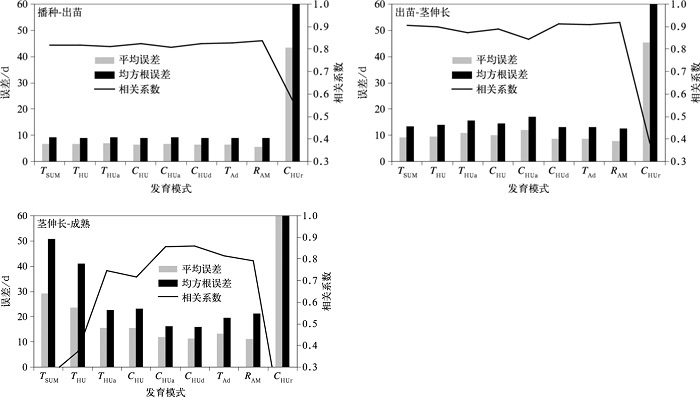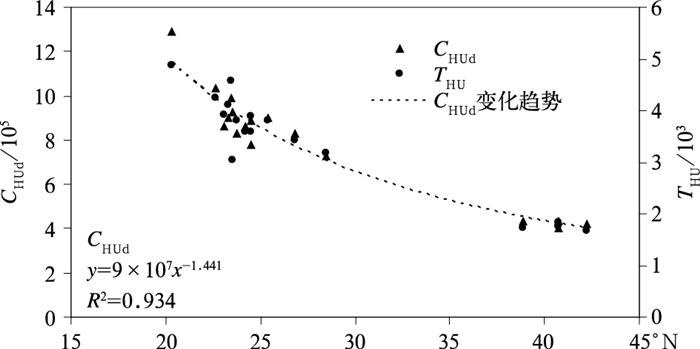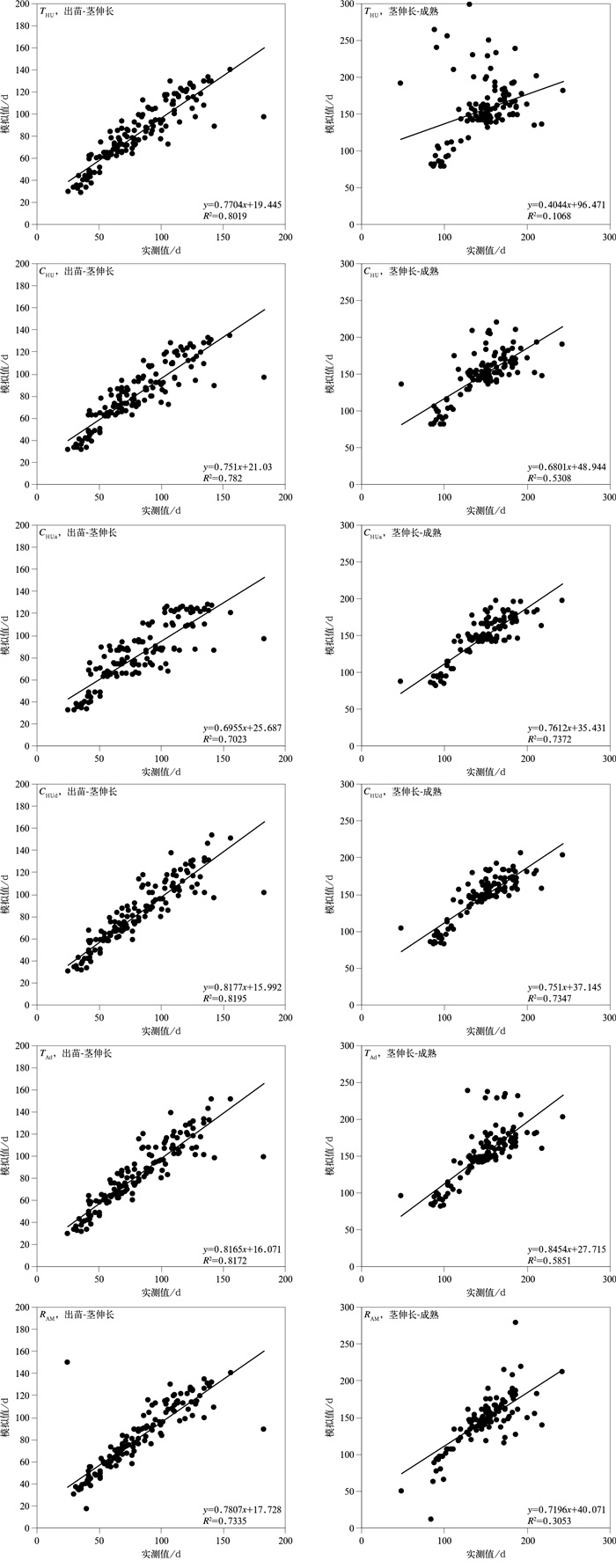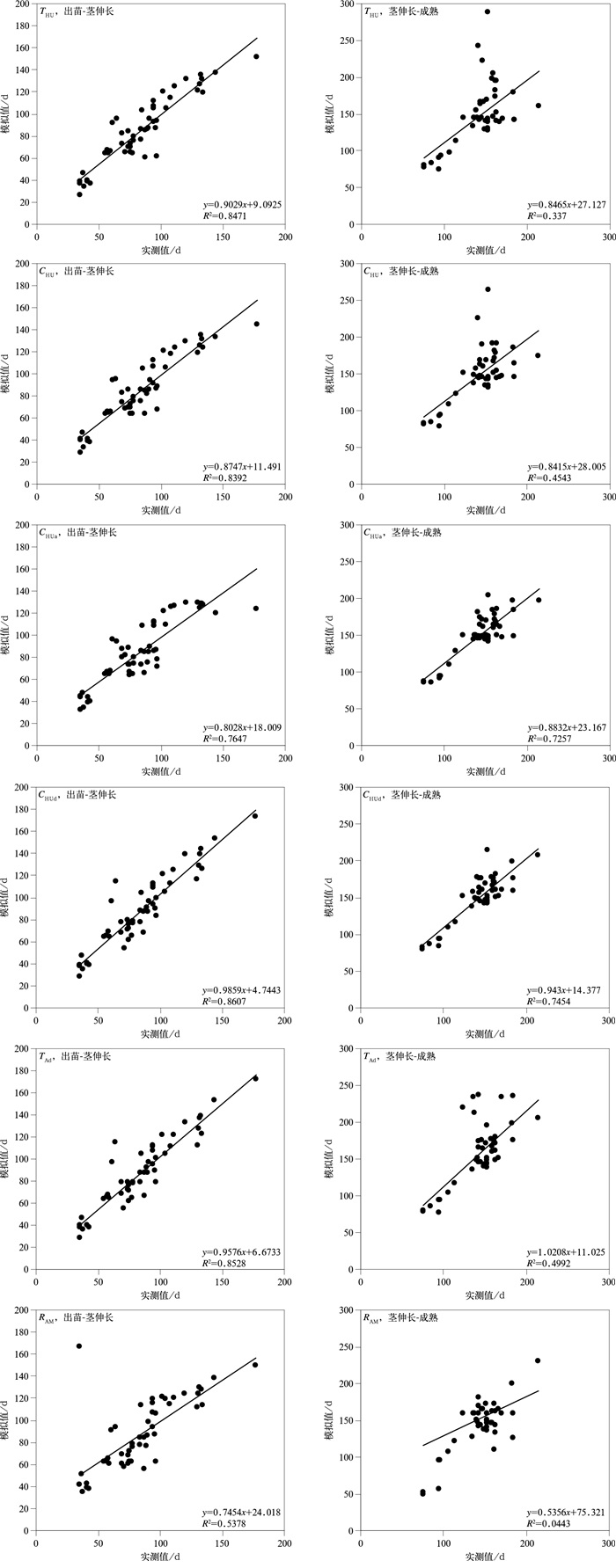Reconstruction of Crop Development Model with Its Simulation Test Based on Sugarcane
-
摘要: 发育进程是作物的生理年龄,发育模式是作物生长模型的时间指针。但目前的发育模式只关注某时段(日)气象条件对作物发育的影响,其准确率也难以满足作物生长模拟的需求。根据作物发育速率不仅与气象条件有关、还与其所处发育期有关的理论假设,重构发育进程模式,并利用1980—2019年我国甘蔗发育实测数据进行模式适应性分析,比较传统模式与重构模式的模拟能力。结果表明:重构模式中,发育单位日序模式和温度日序模式对甘蔗发育进程的适应性均较好,尤其在后期温度不断降低的发育进程以及低温年型的模拟中,其适应能力明显优于传统模式。重构及传统模式模拟能力从强到弱依次为发育单位日序模式、温度日序模式、响应适应模式、发育单位模式、发育单位温度修正模式、热量单位模式,均方根误差计算的模拟能力值依次为4.3,3.9,3.7,3.3,3.0,2.8。Abstract: Crop growth model describes the development and growth process of crop. Development process is the physiological age of crops, which is related to the morphological changes of crops, and is a landmark stage of crop growth to achieve qualitative change. Development process is the time indicator of crop growth model. Reasonable description of the crop development process is the premise of high accuracy of crop growth model. At present, although different crop development models have been developed and widely used in crop growth models, their simulation ability can hardly meet the needs of crop growth simulation. These models only focus on the impact of meteorological conditions in a certain period (day), but do not particularly consider the period of crop development, which may be an important factor for the low accuracy of model simulation.It is assumed that the development rate of a crop on a certain day is not only related to the meteorological conditions of that day, but also related to its development stage. The development stage of crop is represented by the date, so that the temperature-day (TAd) and development unit-day (CHUd) models are constructed. In addition, according to the principle of heat unit corrected by temperature model (THUa), the development unit corrected by temperature model (CHUa) is constructed. Based on the principle of response-adaptation of temperature model (RAM), the response-adaptation of development unit model (CHUr) is established.The adaptability of the development model for sugarcane is analyzed by using the field data of 30 agrometeorological stations in China from 1980 to 2019, and the advantages and disadvantages between the traditional development model and the reconstructed model are compared. The results show that CHUd and TAd model have better adaptability to simulate the development process of sugarcane, especially in the later stage of the development process when the temperature is decreasing. Compared with the original model (CHU), the adaptive ability of CHUa model for sugarcane decreases from seedling emergence to stem elongation but increases from stem elongation to maturity. The theoretical description of CHUr model is not tenable. Sorted by simulation ability, the order of development models is as follows: CHUd, TAd, RAM, CHU, CHUa and the heat unit (THU) model, and their simulation ability values (SCV) calculated by root mean square difference are 4.3, 3.9, 3.7, 3.3, 3.0 and 2.8, respectively.The reconstruction of the development model will further improve the CAMM and promote the development of crop growth simulation theory.
-
Key words:
- development model;
- adaptability;
- sugarcane;
- development period;
- crop growth model
-
表 1 研究数据概况
Table 1 Overview of research data
作物 站点 所在省份 位置 海拔/m 数据时段 新植蔗 乌拉特前旗 蒙 40.7°N,108.7°E 1022.0 1997—2002年 新植蔗 临河 蒙 40.8°N,107.4°E 1040.8 1992—2002年 新植蔗 平罗 宁 38.9°N,106.6°E 1099.9 1993—1999年 新植蔗 赤峰 蒙 42.3°N,119.0°E 568.0 1992—2002年 新植蔗 耿马 云 23.6°N,99.4°E 1105.4 1993—2020年 新植蔗 元江 云 23.4°N,102.0°E 397.6 1994—2020年 新植蔗 泰和 赣 26.8°N,114.9°E 61.8 1993—2003年 新植蔗 广丰 赣 28.4°N,118.2°E 96.1 1994—2009年 新植蔗 仙游 闽 25.4°N,118.7°E 77.0 1993—1997年 新植蔗 宜山 桂 24.5°N,108.7°E 149.8 2003—2009年 新植蔗 沙塘 桂 24.5°N,109.4°E 99.1 2003—2010年 新植蔗 蒙山 桂 24.2°N,110.5°E 147.0 1980—1994年 新植蔗 平果 桂 23.3°N,107.6°E 112.6 1990—2009年 新植蔗 来宾 桂 23.8°N,109.2°E 85.2 2003—2009年 新植蔗 贵县 桂 23.1°N,109.6°E 56.0 1989—2009年 新植蔗 扶绥 桂 22.6°N,107.9°E 88.9 2003—2012年 新植蔗 徐闻 粤 20.3°N,110.2°E 69.0 1992—2001年 宿根蔗 米易 川 26.9°N,102.1°E 1105.8 1992—1998年 宿根蔗 德宏州 云 24.4°N,98.6°E 914.7 1993—2009年 宿根蔗 耿马 云 23.6°N,99.4°E 1105.4 2012—2020年 宿根蔗 蒙自 云 23.4°N,103.4°E 1301.7 2010—2016年 宿根蔗 吉安 赣 27.1°N,115.0°E 78.0 2000—2009年 宿根蔗 泰和 赣 26.8°N,114.9°E 61.8 1992—2009年 宿根蔗 仙游 闽 25.4°N,118.7°E 77.0 1998—2009年 宿根蔗 宜山 桂 24.5°N,108.7°E 149.8 2002—2009年 宿根蔗 沙塘 桂 24.5°N,109.4°E 99.1 2002—2012年 宿根蔗 蒙山 桂 24.2°N,110.5°E 147.0 2002—2009年 宿根蔗 漳浦 闽 24.1°N,117.6°E 51.1 2002—2009年 宿根蔗 平果 桂 23.3°N,107.6°E 112.6 2002—2009年 宿根蔗 贵县 桂 23.1°N,109.6°E 56.0 1996—2009年 表 2 发育模式在部分站点针对新植蔗的参数率定值
Table 2 Calibrated parameter of development models at some sites for new planted sugarcane
站名 纬度 发育模式 THU CHU CHUa CHUd/105 TAd/105 乌拉特前旗 40.7°N 1825.6 2149.1 97.4 4.34 6.34 临河 40.8°N 1741.3 2061.7 94.8 4.04 5.88 平罗 38.9°N 1737.1 2143.9 108.3 4.38 6.43 赤峰 42.3°N 1662.9 2043.3 99.7 4.22 6.13 耿马 23.6°N 3034.5 3723.5 175.2 9.27 13.0 元江 23.4°N 4569.2 4968.3 178.1 9.93 20.1 泰和 26.8°N 3415.9 3898.3 157.6 8.29 11.9 广丰 28.4°N 3190.2 3633.9 145.1 7.30 10.5 仙游 25.4°N 3804.3 4319.8 175.5 9.04 12.8 宜山 24.5°N 3584.3 3946.0 150.9 7.82 11.2 沙塘 24.5°N 3894.0 4366.9 175.4 8.90 12.8 蒙山 24.2°N 3584.3 4049.9 166.8 8.63 12.4 平果 23.3°N 4114.0 4560.1 176.2 9.04 12.9 来宾 23.8°N 3799.4 4149.1 155.4 8.34 11.9 贵县 23.1°N 3918.3 4315.0 164.3 8.60 12.3 扶绥 22.6°N 4242.6 4687.0 179.4 10.4 15.0 徐闻 20.3°N 4888.2 5446.8 207.7 12.9 18.0 表 3 发育模式对新植蔗回代模拟误差
Table 3 Back training simulation error of development model for new planted sugarcane
发育阶段 模式 相关系数 平均偏差/d 平均误差/d 平均相对误差/d 均方根误差/d 样本量 播种-出苗 THU 0.82 1.1 6.2 19.6 8.9 66 CHU 0.83 0.8 6.0 18.7 8.6 66 CHUa 0.82 1.3 6.3 19.2 8.9 66 CHUd 0.83 1.6 6.2 20.5 9.1 66 TAd 0.83 1.4 6.1 20.0 8.9 66 RAM 0.84 -1.5 5.4 15.1 8.7 66 出苗-茎伸长 THU 0.90 0.5 9.5 12.2 14.2 137 CHU 0.88 0.5 10.3 13.1 14.9 137 CHUa 0.84 0.6 12.7 16.1 17.3 137 CHUd 0.91 0.9 8.9 11.2 13.5 137 TAd 0.90 0.9 8.9 11.2 13.6 137 RAM 0.86 -0.4 8.3 12.2 16.5 137 茎伸长-成熟 THU 0.33 8.4 25.2 20.2 43.0 120 CHU 0.73 1.6 15.5 11.4 23.0 120 CHUa 0.86 0.1 12.0 8.3 16.5 120 CHUd 0.86 0.3 11.8 8.5 16.6 120 TAd 0.76 4.9 14.9 10.3 23.9 120 RAM 0.55 -1.4 16.2 11.9 36.1 120 表 4 发育模式对新植蔗独立样本模拟误差
Table 4 Development model simulation errors based on independent samples for new planted sugarcane
发育阶段 模式 相关系数 平均偏差/d 平均误差/d 平均相对误差/d 均方根误差/d 样本量 播种-出苗 THU 0.83 2.6 6.6 31.5 9.1 24 CHU 0.82 2.5 6.5 31.2 9.2 24 CHUa 0.81 3.3 6.6 32.2 9.6 24 CHUd 0.81 3.0 6.9 31.7 10.1 24 TAd 0.81 3.0 6.9 32.0 9.9 24 RAM 0.81 1.4 6.2 29.1 9.1 24 出苗-茎伸长 THU 0.92 0.9 9.1 11.8 12.4 52 CHU 0.92 1.0 9.6 12.3 12.7 52 CHUa 0.87 1.5 11.5 14.6 15.3 52 CHUd 0.93 3.6 8.9 11.8 12.9 52 TAd 0.92 3.1 8.9 11.8 12.9 52 RAM 0.73 2.7 13.0 20.3 23.2 52 茎伸长-成熟 THU 0.58 5.0 22.9 15.1 35.0 46 CHU 0.67 5.2 18.2 12.2 27.5 46 CHUa 0.85 6.3 12.6 8.8 17.3 46 CHUd 0.86 6.2 12.4 8.5 17.2 46 TAd 0.71 14.0 19.8 13.7 32.8 46 RAM 0.21 12.2 29.1 24.0 70.1 46 表 5 发育模式在不同检验中的模拟能力
Table 5 Simulation ability of development models in different tests
发育阶段 模式 新植蔗 宿根蔗 SCV 全样本 参数率定 独立样本 全样本 参数率定 独立样本 播种-出苗 THU 2 4 6 4.0 CHU 5 6 4 5.0 CHUa 1 3 3 2.3 CHUd 3 1 1 1.7 TAd 4 2 2 2.7 RAM 6 5 5 5.3 出苗/发株-茎伸长 THU 3 4 6 3 3 4 3.8 CHU 2 3 5 2 2 3 2.8 CHUa 1 1 2 1 1 1 1.2 CHUd 5 6 4 4 5 6 5.0 TAd 4 5 3 5 4 5 4.3 RAM 6 2 1 6 6 2 3.8 茎伸长-成熟 THU 1 1 2 2 1 1 1.3 CHU 2 4 4 3 2 2 2.8 CHUa 5 6 5 6 5 4 5.2 CHUd 6 5 6 4 3 5 4.8 TAd 4 3 3 5 4 6 4.2 RAM 3 2 1 1 6 3 2.7 -
[1] Sinclair T R, Seligman N A G.Crop modeling:From infancy to maturity. Agron J, 1996, 88(5):698-704. doi: 10.2134/agronj1996.00021962008800050004x [2] Monteith J L. The quest for balance in crop modeling. Agron J, 1996, 88(5): 695-697. doi: 10.2134/agronj1996.00021962008800050003x [3] Edwards D, Hamson M. Guide to Mathematical Modelling. London: MacMillan Press Ltd, 1989: 1-277. [4] Hoogenboom G. Contribution of agrometeorology to the simulation of crop production and its applications. Agr Forest Meteorol, 2000, 103(1/2): 137-157. [5] 马玉平, 霍治国, 王培娟, 等. 中国农业气象模式(CAMM1.0)构建与应用. 应用气象学报, 2019, 30(5): 528-542. doi: 10.11898/1001-7313.20190502Ma Y P, Huo Z G, Wang P J, et al. The construction and application of Chinese Agrometeorological Model(CAMM1.0). J Appl Meteor Sci, 2019, 30(5): 528-542. doi: 10.11898/1001-7313.20190502 [6] Van Diepen C A, Wolf J, van Keulen H, et al. WOFOST: A simulation model of crop production. Soil Use Manage, 1989, 5: 16-24. doi: 10.1111/j.1475-2743.1989.tb00755.x [7] Kropff M J, van Laar H H, Matthews R B. ORYZA1: An Ecophysiological Model for Irrigated Rice Production. SARP Research Proceedings, Wageningen(Netherlands): IRRI/AB-DLO, 1994. [8] Gao L Z, Jin Z Q, Huang Y, et al. Rice clock model-A computer model to simulate rice development. Agr Forest Meteorol, 1992, 60(1/2): 1-16. [9] Keating B A, Carberry P S, Hammer G L, et al. An overview of APSIM, a model designed for farming systems simulation. Eur J Agron, 2003, 18(3/4): 267-288. [10] Jones A J W, Hoogenboom B G, Porter A C H, et al. The DSSAT cropping system model. Eur J Agron, 2003, 18(3/4): 235-265. http://europepmc.org/abstract/AGR/IND44696208 [11] Kapetanaki G, Rosenzweig C. Impact of climate change on maize yield in central and northern Greece: A simulation study with Ceres-Maize. Mitig Adapt Strat Gl, 1997, 1(3): 251-271. doi: 10.1007/BF00517806 [12] Ceglar A, Bogataj L K. Simulation of maize yield in current and changed climatic conditions: Addressing modelling uncertainties and the importance of bias correction in climate model simulations. Eur J Agron, 2012, 37(1): 83-95. doi: 10.1016/j.eja.2011.11.005 [13] 金之庆, 葛道阔, 郑喜莲, 等. 评价全球气候变化对我国玉米生产的可能影响. 作物学报, 1996, 22(5): 513-524. doi: 10.3321/j.issn:0496-3490.1996.05.001Jin Z Q, Ge D K, Zheng X L, et al. Assessing the potential impacts of global climate change on maize production in China. Acta Agronomica Sinica, 1996, 22(5): 513-524. doi: 10.3321/j.issn:0496-3490.1996.05.001 [14] Yin X, Chasalow S D, Dourleijn C J, et al. Coupling estimated effects of QTLs for physiological traits to a crop growth model: Predicting yield variation among recombinant inbred lines in barley. Heredity(Edinb), 2000, 85(6): 539-549. [15] 王石立, 马玉平. 作物生长模拟模型在我国农业气象业务中的应用研究进展及思考. 气象, 2008, 34(6): 3-10. https://www.cnki.com.cn/Article/CJFDTOTAL-QXXX200806002.htmWang S L, Ma Y P. The progress in application of crop growth simulation models to agro-meteorological services in China. Meteor Mon, 2008, 34(6): 3-10. https://www.cnki.com.cn/Article/CJFDTOTAL-QXXX200806002.htm [16] 高亮之. 农业模型学基础. 香港: 天马图书有限公司, 2004.Gao L Z. Foundation of Agricultural Modeling Science. Hong-kong: Tianma Books Ltd, 2004. [17] 黄健熙, 黄海, 马鸿元, 等. 遥感与作物生长模型数据同化应用综述. 农业工程学报, 2018, 34(21): 144-156. doi: 10.11975/j.issn.1002-6819.2018.21.018Huang J X, Huang H, Ma H Y, et al. Review on data assimilation of remote sensing and crop growth models. Transactions of the Chinese Society of Agricultural Engineering, 2018, 34(21): 144-156. doi: 10.11975/j.issn.1002-6819.2018.21.018 [18] 帅细强, 王石立, 马玉平, 等. 基于水稻生长模型的气象影响评价和产量动态预测. 应用气象学报, 2008, 19(1): 71-81. doi: 10.3969/j.issn.1001-7313.2008.01.010Shuai X Q, Wang S L, Ma Y P, et al. Assessment of meteorological condition effects and dynamic yield forecasting based on rice growth model. J Appl Meteor Sci, 2008, 19(1): 71-81. doi: 10.3969/j.issn.1001-7313.2008.01.010 [19] 熊伟. CERES-Wheat模型在我国小麦区的应用效果及误差来源. 应用气象学报, 2009, 20(1): 88-94. doi: 10.3969/j.issn.1001-7313.2009.01.011Xiong W. The performance of CERES wheat model in wheat planting areas and its uncertainties. J Appl Meteor Sci, 2009, 20(1): 88-94. doi: 10.3969/j.issn.1001-7313.2009.01.011 [20] 侯英雨, 张蕾, 吴门新, 等. 国家级现代农业气象业务技术进展. 应用气象学报, 2018, 29(6): 641-656. doi: 10.11898/1001-7313.20180601Hou Y Y, Zhang L, Wu M X, et al. Advance of modern agrometeorological service and technology in China. J Appl Meteor Sci, 2018, 29(6): 641-656. doi: 10.11898/1001-7313.20180601 [21] 帅细强, 陆魁东, 黄晚华. 不同方法在湖南省早稻产量动态预报中的比较. 应用气象学报, 2015, 26(1): 103-111. doi: 10.11898/1001-7313.20150111Shuai X Q, Lu K D, Huang W H. A comparative study on dynamic forecasting of early rice yield by using different methods in Hunan Province. J Appl Meteor Sci, 2015, 26(1): 103-111. doi: 10.11898/1001-7313.20150111 [22] 刘布春, 王石立, 庄立伟, 等. 基于东北玉米区域动力模型的低温冷害预报应用研究. 应用气象学报, 2003, 14(5): 616-625. doi: 10.3969/j.issn.1001-7313.2003.05.012Liu B C, Wang S L, Zhuang L W, et al. Study of low temperature damage prediction applications in Northeast China based on a scaling-up maize dynamic model. J Appl Meteor Sci, 2003, 14(5): 616-625. doi: 10.3969/j.issn.1001-7313.2003.05.012 [23] McMaster G S, Wilhelm W W. Phenological responses of wheat and barley to water and temperature: Improving simulation models. J Agric Sci, 2003, 141(2): 129-148. doi: 10.1017/S0021859603003460 [24] 刘健, 姚宁, 吝海霞, 等. 冬小麦物候期对土壤水分胁迫的响应机制与模拟. 农业工程学报, 2016, 32(21): 115-124. doi: 10.11975/j.issn.1002-6819.2016.21.016Liu J, Yao N, Lin H X, et al. Response mechanism and simulation of winter wheat phonology to soil water stress. Transactions of the Chinese Society of Agricultural Engineering, 2016, 32(21): 115-124. doi: 10.11975/j.issn.1002-6819.2016.21.016 [25] McMaster G S, Wilhelm W W. Growing degree-days: One equation, two interpretations. Agr Forest Meteorol, 1997, 87(4): 291-300. doi: 10.1016/S0168-1923(97)00027-0 [26] 王石立, 马玉平, 庄立伟. 东北地区玉米冷害预测评估模型改进研究. 自然灾害学报, 2008, 17(4): 12-18. doi: 10.3969/j.issn.1004-4574.2008.04.003Wang S L, Ma Y P, Zhuang L W. Improvement study on prediction and assessment model for chilling damage of maize in Northeast China. Journal of Natural Disasters, 2008, 17(4): 12-18. doi: 10.3969/j.issn.1004-4574.2008.04.003 [27] 马玉平, 王石立, 李维京. 基于作物生长模型的玉米生殖期冷害致灾因子研究. 作物学报, 2011, 37(9): 1642-1649. doi: 10.3969/j.issn.1000-2561.2011.09.010Ma Y P, Wang S L, Li W J. Chilling disaster factors in maize reproductive stage based on crop growth model. Acta Agronomica Sinica, 2011, 37(9): 1642-1649. doi: 10.3969/j.issn.1000-2561.2011.09.010 [28] Brown D M, Chapman L J. Soybean ecology. Ⅱ. Development-temperature-moisture relationships from field studies. Agron J, 1960, 52(9): 496-499. doi: 10.2134/agronj1960.00021962005200090002x [29] Matthews R B, Hunt L A. GUMCAS: A model describing the growth of cassava(Manihot esculenta L. Crantz). Field Crop Res, 1994, 36(1): 69-84. doi: 10.1016/0378-4290(94)90054-X [30] 马玉平, 张黎, 孙琳丽, 等. 持续性温强和土壤水分对玉米发育进程的影响及其模拟. 中国农学通报, 2015, 3(3): 186-193. https://www.cnki.com.cn/Article/CJFDTOTAL-ZNTB201503032.htmMa Y P, Zhang L, Sun L L, et al. Effects of continuous temperature and soil moisture on development process of maize and its simulation. Chinese Agricultural Science Bulletin, 2015, 3(3): 186-193. https://www.cnki.com.cn/Article/CJFDTOTAL-ZNTB201503032.htm [31] Wang E, Martre P, Zhao Z, et al. The uncertainty of crop yield projections is reduced by improved temperature response functions. Nat Plants, 2017, 3(8): 17102. doi: 10.1038/nplants.2017.102 [32] 高亮之, 金之庆, 黄耀, 等. 作物模拟与栽培优化原理的结合-RCSODS. 作物杂志, 1994(3): 4-7. https://www.cnki.com.cn/Article/CJFDTOTAL-ZWZZ403.002.htmGao L Z, Jin Z Q, Huang Y, et al. Combination of crop simulation and cultivation optimization principle-RCSODS. Crops, 1994(3): 4-7. https://www.cnki.com.cn/Article/CJFDTOTAL-ZWZZ403.002.htm [33] Yin X Y. A nonlinear model to quantify temperature effect on rice phenology and its application. Acta Agronomica Sinica, 1994, 20(6): 692-700. [34] Wu D, Wang P, Jiang C, et al. Use of a plastic temperature response function reduces simulation error of crop maturity date by half. Agr Forest Meteorol, 2020, 280: 107770. doi: 10.1016/j.agrformet.2019.107770 [35] 黄秋燕, 覃志豪, 覃梓洪, 等. 甘蔗灾害监测研究进展及展望. 中国农业信息, 2018, 30(3): 23-40. https://www.cnki.com.cn/Article/CJFDTOTAL-NXTS201803005.htmHuang Q Y, Qin Z H, QiN Z H, et al. Research progress and prospect on the monitoring of sugarcane disaster. China Agricultural Informatics, 2018, 30(3): 23-40. https://www.cnki.com.cn/Article/CJFDTOTAL-NXTS201803005.htm [36] 李祎君, 王春乙, 赵蓓, 等. 气候变化对中国农业气象灾害与病虫害的影响. 农业工程学报, 2010, 26(增刊I): 263-271. https://www.cnki.com.cn/Article/CJFDTOTAL-NYGU2010S1049.htmLi Y J, Wang C Y, Zhao B, et al. Effects of climate change on agricultural meteorological disaster and crop insects diseases. Transactions of the Chinese Society of Agricultural Engineering, 2010, 26(Suppl I): 263-271. https://www.cnki.com.cn/Article/CJFDTOTAL-NYGU2010S1049.htm [37] 潘小军, 张忠斌, 蒲成毅. 全球气候异常下甘蔗气象灾害风险分析. 保险研究, 2014(12): 51-58. https://www.cnki.com.cn/Article/CJFDTOTAL-BXYJ201412007.htmPan X J, Zhang Z B, Pu C Y. Risk analysis of sugarcane meteorological disaster under global climate anomaly. Insurance Studies, 2014(12): 51-58. https://www.cnki.com.cn/Article/CJFDTOTAL-BXYJ201412007.htm [38] 李莉, 匡昭敏, 莫建飞, 等. 广西甘蔗秋旱灾害风险评估技术初步研究. 应用气象学报, 2016, 27(1): 95-101. doi: 10.11898/1001-7313.20160110Li L, Kuang Z M, Mo J F, et al. Assessment of autumn drought risk of sugarcane in Guangxi. J Appl Meteor Sci, 2016, 27(1): 95-101. doi: 10.11898/1001-7313.20160110 [39] 匡昭敏, 李强, 尧永梅, 等. EOS/MODIS数据在甘蔗寒害监测评估中的应用. 应用气象学报, 2009, 20(3): 360-364. doi: 10.3969/j.issn.1001-7313.2009.03.013Kuang Z M, Li Q, Yao Y M, et al. Application of EOS/MODIS data to monitoring sugarcane cold damage. J Appl Meteor Sci, 2009, 20(3): 360-364. doi: 10.3969/j.issn.1001-7313.2009.03.013 [40] 廖东声, 覃思静. 广西甘蔗产业生产成本核算及控制问题分析. 学术论坛, 2013(8): 83-87. doi: 10.3969/j.issn.1004-4434.2013.08.018Liao D S, Qin S J. Analysis on production cost accounting and control of sugarcane industry in Guangxi. Academic Forum, 2013(8): 83-87. doi: 10.3969/j.issn.1004-4434.2013.08.018 [41] Inman-bamber N G, Everingham Y L, Muchow R C. Modelling Water Stress Response in Sugarcane: Validation and Application of the APSIM-Sugarcane Model. (2001-02-01)[2020-12-08]. http://www.regional.org.au/au/asa/2001/6/d/inmanbamber.htm. [42] Keating B A, Robertson M J, Muchow R C, et al. Modelling sugarcane production systems Ⅰ. Development and performance of the sugarcane module. Field Crop Res, 1999, 61(3): 253-271. doi: 10.1016/S0378-4290(98)00167-1 [43] Liu D L, Bull T A. Simulation of biomass and sugar accumulation in sugarcane using a process-based model. Ecol Model, 2001, 144(2/3): 181-211. [44] Inman-Bamber N G. A growth model for sugar-cane based on a simple carbon balance and the CERES-Maize water balance. South African Journal of Plant and Soil, 1991, 8(2): 93-99. doi: 10.1080/02571862.1991.10634587 [45] Leary G J O. A review of three sugarcane simulation models with respect to their prediction of sucrose yield. Field Crop Res, 2000, 68(2): 97-111. doi: 10.1016/S0378-4290(00)00112-X [46] 王培娟, 马玉平, 霍治国, 等. 土壤水分对冬小麦叶片光合速率影响模型构建. 应用气象学报, 2020, 31(3): 267-279. doi: 10.11898/1001-7313.20200302Wang P J, Ma Y P, Huo Z G, et al. Construction of the model for soil moisture effects on leaf photosynthesis rate of winter wheat. J Appl Meteor Sci, 2020, 31(3): 267-279. doi: 10.11898/1001-7313.20200302 -


 设为首页
设为首页 加入收藏
加入收藏



 下载:
下载:



